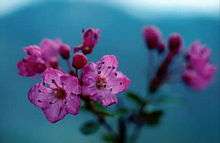Kalmiopsis leachiana
Kalmiopsis leachiana, commonly referred to as kalmiopsis, is a rare flowering plant endemic to the Siskiyou Mountains of southwest Oregon, where it is specially protected in the 179,755-acre (727.4 km2) Kalmiopsis Wilderness reserve. It was discovered in 1930 by Lilla Leach in the Gold Basin area.[1]
| Kalmiopsis leachiana | |
|---|---|
 | |
| Scientific classification | |
| Kingdom: | Plantae |
| Clade: | Tracheophytes |
| Clade: | Angiosperms |
| Clade: | Eudicots |
| Clade: | Asterids |
| Order: | Ericales |
| Family: | Ericaceae |
| Genus: | Kalmiopsis |
| Species: | K. leachiana |
| Binomial name | |
| Kalmiopsis leachiana (Henderson) Rehd. | |
Description
Kalmiopsis leachiana is an evergreen shrub growing to 10–30 centimetres (0.33–0.98 ft) tall, with erect stems bearing spirally arranged simple leaves 2–3 cm long and 1 cm broad.
The flowers are pink-purple, in racemes of 6-9 together, reminiscent of small Rhododendron flowers but flatter, with a star-like calyx of five conjoined petals; each flower is 1.5–2 cm diameter. The fruit is a five-lobed capsule, which splits to release the numerous small seeds.
External links
| Wikimedia Commons has media related to Kalmiopsis leachiana. |
| Wikispecies has information related to Kalmiopsis leachiana |
